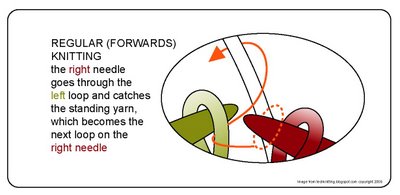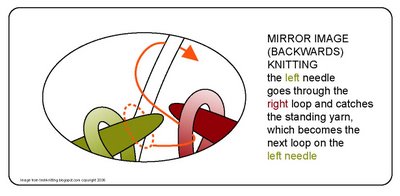 In all of knittingdom, there are only 2 stitches: The KNIT (K) stitch and the PURL (P) stitch. (Well, perhaps there are 3? A yarn over (YO) is neither a knit nor a purl. On the other hand, a YO may not be a stitch at all, so maybe we are back to 2?)
As soon as you master these 2 (3?) stitches, you can make anything at all in all of knitting; cables, picots, stockinette fabric, garter-stitch fabric, lace. This all seems simple, and, in a zen-like sort of way, it is. However, the complications soon start cascading and obscuring all.
The first complication stems from the split between knitting's two main divisions: continental knitters who carry the working yarn on their left hands, and English knitters, who carry the yarn on their right hands.
Knitters argue about which method is "better." Speed records are set by both kinds of knitters. I believe the best way to knit is the way that you, personally, prefer. The next 4 posts will illustrate both continental and English knitting and purling--if you don't already know how to do these, you could try them and make up your own mind.
But before the how-to posts, THIS post is about how the continental style and English style differ, and why handedness (left-handed, right-handed) has only a little to do with which style will work better for YOU.
In all of knittingdom, there are only 2 stitches: The KNIT (K) stitch and the PURL (P) stitch. (Well, perhaps there are 3? A yarn over (YO) is neither a knit nor a purl. On the other hand, a YO may not be a stitch at all, so maybe we are back to 2?)
As soon as you master these 2 (3?) stitches, you can make anything at all in all of knitting; cables, picots, stockinette fabric, garter-stitch fabric, lace. This all seems simple, and, in a zen-like sort of way, it is. However, the complications soon start cascading and obscuring all.
The first complication stems from the split between knitting's two main divisions: continental knitters who carry the working yarn on their left hands, and English knitters, who carry the yarn on their right hands.
Knitters argue about which method is "better." Speed records are set by both kinds of knitters. I believe the best way to knit is the way that you, personally, prefer. The next 4 posts will illustrate both continental and English knitting and purling--if you don't already know how to do these, you could try them and make up your own mind.
But before the how-to posts, THIS post is about how the continental style and English style differ, and why handedness (left-handed, right-handed) has only a little to do with which style will work better for YOU.
CONFUSION
There is a lot of confusion about the difference between continental and English knitting. For me, learning to knit continental arose from this confusion.
I did not learn to knit until I was 24 years old--old enough to get my own way with my very stubborn mother. Before that, my mother refused to teach me because she thought she would teach me the "wrong" way--the continental way--which she had learned as a girl in Germany. She thought that I should learn "regular" (English) knitting so I could follow knitting patterns written in English--she thought continental knitting was "backwards" to English knitting.
My mom was confused (and did I mention? stubborn...). It is true that continental knitting and English knitting differ. However, the stitch which results--the loop on the needle--is the same (and the same knitting patterns work for both).
The difference between continental and English knitting arises ONLY from which hand holds the working yarn. In continental knitting, the working yarn is held on the left hand, so that the tip of the right needle "picks" the yarn to draw it through the loop. In English knitting, the working yarn is held on the right hand, and the working yarn is "thrown" around the tip of the right needle, then drawn through the loop.
If you ignore the hands supplying the yarn and watch only the needles, the ACT of drawing a new loop through the old loop is the same in continental and in English knitting:
click picture
 *the loop to be worked is held at the very tip of the left needle
*the tip of the right needle reaches through that loop, snags the standing yarn "up from under," and pulls that snag through the left loop.
*by this act, two things happen simultaneously: first, as the right needle draws the snag through the left (old) loop, the snag enlarges to become a new loop, second, the new loop is transferred to the right needle.
*the loop to be worked is held at the very tip of the left needle
*the tip of the right needle reaches through that loop, snags the standing yarn "up from under," and pulls that snag through the left loop.
*by this act, two things happen simultaneously: first, as the right needle draws the snag through the left (old) loop, the snag enlarges to become a new loop, second, the new loop is transferred to the right needle.
HANDEDNESS
Some think that continental and English knitting have to do with handedness--left handedness, right handedness. That's not correct--both righties and lefties can and do knit both ways. click picture
 What some call "left- handed knitting" is actually MIRROR-IMAGE ("Backwards") knitting: using the left needle to draw a new loop through a stitch on the tip of the right needle. This transfers the new stitch onto the left needle and generally leaves the new stitch oriented backwards--that is, left arm forward. The act of supplying the yarn also changes hands, with the right hand carrying the standing yarn in continental knitting, and the left hand supplying the yarn in English knitting.
There are knitting teachers who use a mirror to teach this way.
What some call "left- handed knitting" is actually MIRROR-IMAGE ("Backwards") knitting: using the left needle to draw a new loop through a stitch on the tip of the right needle. This transfers the new stitch onto the left needle and generally leaves the new stitch oriented backwards--that is, left arm forward. The act of supplying the yarn also changes hands, with the right hand carrying the standing yarn in continental knitting, and the left hand supplying the yarn in English knitting.
There are knitting teachers who use a mirror to teach this way. I myself would not start with this approach. Knitting is (usually, but not always) a two-handed activity--the right-handed have just as much trouble learning to control their left hands as the left-handed have controlling their rights. The left-handed are (for once) at no disadvantage.
However, it may be that a left-handed person will be more comfortable with continental knitting--in that style the left hand gets to do more work than in English style. I'd try that before going on to mirror-image knitting.
To those of you who already knit mirror-image: you have my admiration for your perseverance and persistence in a knitting world which lies somewhat backwards to you--in that technical instructions about right and left needles have to be transposed. To those of you who are left handed and have yet to learn to knit, try continental first.
Amended February 2007, edited October 2022
A new final conclusion: I myself have taught at least a half-dozen different left handed people to knit "regular" over the years. I also know several additional left handed people who knit continental with no problem. It was based on this experience that I originally wrote this post in 2006.
HOWEVER...dear readers, I have just heard from Jenny, a left-handed reader who posted in the comments. She has had quite a different experience--she tried to learn regular knitting--English AND continental, and she STILL found mirror image knitting easier. So, evidently, sometimes a left-handed person has to choose between mirror image knitting or no knitting. In that case the choice is easy--knitting is SO obviously more fun than not-knitting.
Bottom line: I would start off trying to teach a left handed person to knit "regular," concentrating on the continental style. BUT, if you try and try, dear lefty, and still can't knit, not even continental, then we'll all have to swallow the fact that transposing patterns is not THAT big a deal, and learn to knit mirror image accordingly.
--TK
--TK